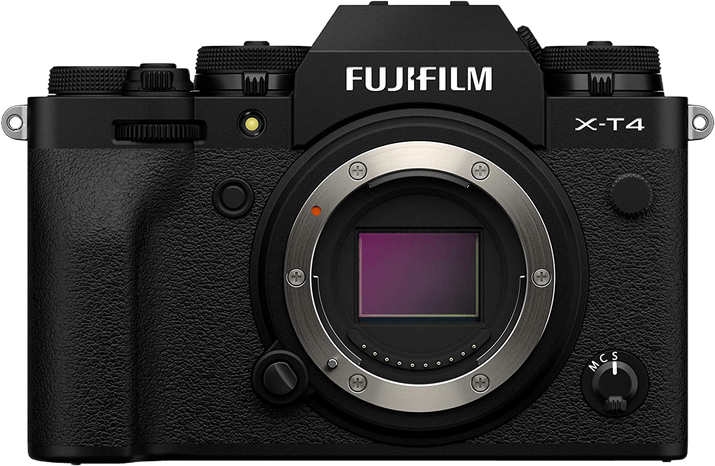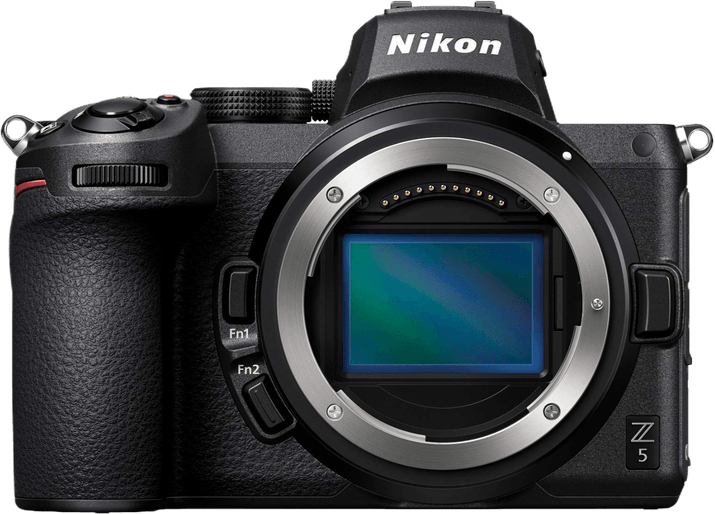Fujifilm X-T4 vs Nikon Z5 Comparison
Fujifilm X-T4

Nikon Z5

The Nikon Z5 narrowly beats the Fujifilm X-T4 with a score of 78/100 compared to the X-T4’s 76/100. Both cameras are mirrorless and were released in 2020, with the Z5 being slightly more affordable at $1,400 compared to the X-T4’s $1,699.
The Fujifilm X-T4 is lighter and larger, weighing 607g and measuring 135 x 93 x 84mm. This makes it more portable and easier to handle than the Nikon Z5, which weighs 675g and measures 134 x 100.5 x 69.5mm. However, the Nikon Z5’s higher score indicates it offers better overall performance and features.
While the Fujifilm X-T4 has advantages in size and weight, the Nikon Z5 takes the lead with its superior score, making it a better choice for those who prioritize performance.
Fujifilm X-T4 vs Nikon Z5 Overview and Optics
The Nikon Z5 outperforms the Fujifilm X-T4 in optics, with a score of 81/100 compared to the X-T4’s 73/100. Both cameras share common specifications, such as CMOS sensor type, image stabilisation, and lens mounts compatible with their respective brands. However, the differences in their performance lie in other aspects of their optics.
The Nikon Z5 excels with its full-frame sensor size, which offers better image quality and low-light performance compared to the Fujifilm X-T4’s APS-C sensor. Additionally, the Z5 has a DXOMARK score of 97 for its sensor, which indicates its high-quality performance. On the other hand, the Fujifilm X-T4 has no DXOMARK score, as the platform does not evaluate Fujifilm cameras. The Z5’s Expeed 6 processor also contributes to its superior performance in image processing and overall speed.
While the Fujifilm X-T4 has a higher megapixel count of 26 compared to the Nikon Z5’s 24, it does not necessarily translate to better image quality. The X-T4’s advantage lies in its shooting speed of 20 frames per second, significantly faster than the Z5’s 4.5. This feature makes the X-T4 more suitable for capturing fast-moving subjects and action shots.
Despite the Nikon Z5’s superior optics score and performance, the Fujifilm X-T4’s faster shooting speed may appeal to specific users. Ultimately, photographers must consider their individual needs and preferences when deciding between these two cameras. The Nikon Z5 is the better choice for those prioritising image quality and low-light performance, while the Fujifilm X-T4 is ideal for capturing fast-paced action.
Fujifilm X-T4 vs Nikon Z5 Video Performance
The Fujifilm X-T4 outperforms the Nikon Z5 in video capabilities with a score of 91/100 compared to the Nikon Z5’s score of 83/100. Both cameras share some common video specifications, such as 4K max video resolution and built-in time-lapse functionality. However, the Fujifilm X-T4 surpasses the Nikon Z5 in certain aspects, making it a better choice for video enthusiasts.
One significant advantage of the Fujifilm X-T4 is its max video dimensions of 4096 x 2160, compared to the Nikon Z5’s 3840 x 2160. This difference allows the X-T4 to capture more detailed and higher quality footage. Additionally, the X-T4 boasts a max video frame rate of 120fps, doubling the Z5’s 60fps. This higher frame rate enables smoother slow-motion footage and better overall video performance.
Despite its lower score, the Nikon Z5 still has some strengths in its video capabilities. The Z5 matches the Fujifilm X-T4 in max video resolution, offering 4K quality. Furthermore, it shares the built-in time-lapse functionality with the X-T4, allowing users to create stunning time-lapse videos without additional software or equipment.
Taking these factors into account, the Fujifilm X-T4 is the clear winner in video capabilities due to its higher max video dimensions and superior frame rate. While the Nikon Z5 still offers 4K resolution and time-lapse functionality, it falls short in comparison to the X-T4’s performance. For those prioritizing video, the Fujifilm X-T4 is the better choice, while the Nikon Z5 remains a viable option for those who value 4K resolution and time-lapse features.
Fujifilm X-T4 vs Nikon Z5 Features and Benefits
The Fujifilm X-T4 outperforms the Nikon Z5 in features, scoring 85/100 compared to the Z5’s 72/100. Both cameras share several similar specifications, including a touchscreen, flip screen, lack of GPS, and connectivity options like WIFI and Bluetooth.
The X-T4’s superiority is evident in its screen resolution, which stands at 1,620,000 dots, providing a sharper and clearer display compared to the Z5’s 1,040,000 dots. This difference in resolution allows for better image preview and easier menu navigation on the X-T4.
On the other hand, the Nikon Z5 has a slightly larger screen size of 3.2 inches, compared to the Fujifilm X-T4’s 3 inches. This can make it easier for some users to view and compose their shots. However, the lower screen resolution on the Z5 somewhat negates this advantage, as the overall image quality and clarity will still be inferior to the X-T4.
Regarding features, the Fujifilm X-T4 takes the lead with its higher resolution screen, while the Nikon Z5 offers a marginally larger screen size. It is essential to consider these differences when choosing between the two cameras, as each may cater to different user preferences and requirements. Ultimately, the X-T4’s superior screen resolution makes it a better choice for those prioritizing image quality and ease of use in their camera’s features.
Fujifilm X-T4 vs Nikon Z5 Storage and Battery
The Fujifilm X-T4 and Nikon Z5 both score 73/100 in storage and battery, indicating equal performance in this category. They share common specifications, including two memory card slots and compatibility with SD/SDHC/SDXC (UHS-II) memory cards. Additionally, both cameras offer USB charging capabilities.
The Fujifilm X-T4 has a slight advantage in battery life, providing 500 shots per charge compared to the Nikon Z5’s 470 shots. This difference, though small, gives the X-T4 a slight edge for longer shooting sessions. The X-T4 uses the NP-W235 battery type.
On the other hand, the Nikon Z5 also performs well with its EN-EL15c battery type, offering only 30 shots less than the X-T4. This difference may not be significant for casual photographers, but may matter for professionals.
Considering their identical scores and similar specifications, both the Fujifilm X-T4 and Nikon Z5 offer reliable storage and battery performance. While the X-T4 has a marginal advantage in battery life, the Nikon Z5 remains a strong contender for those seeking a camera with dependable storage and battery capabilities.
Fujifilm X-T4 vs Nikon Z5 – Our Verdict
Are you still undecided about which camera is right for you? Have a look at these popular comparisons that feature the Fujifilm X-T4 or the Nikon Z5:

